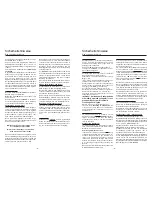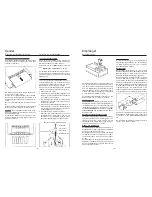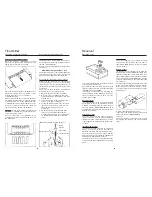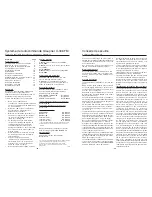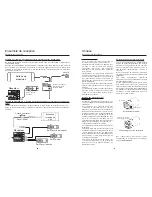
Safety notes
This is essential reading!
Always install servos using the vibration-damping
grommets supplied. The rubber grommets
provide some degree of protection from
mechanical shock and severe vibration.
Always extend the transmitter aerial fully before
operating your model.
Transmitter field strength is at a minimum in an
imaginary line extending straight out from the
transmitter aerial. It is therefore fundamentally
misguided to „point“ the transmitter aerial at the
model in the hope of obtaining good reception.
When several radio control systems are in use
on adjacent channels, the drivers or pilots should
always stand together in a loose group. Opera-
tors who insist on standing away from the group
endanger their own models as well as those of
the other modellers.
Correct behaviour
Model cars should never be run on public roads,
footpaths, squares etc.
Take care at all times not to endanger people,
animals or other modellers.
Keep well clear of high-tension overhead cables.
Never run your model boat close to locks or full-
size boats.
Pre-flight / pre-run checking
If there are several modellers at the site, check
carefully with all of them that you are the only
one on „your“ channel before you switch on your
own transmitter. If two modellers switch on
transmitters on the same channel, the result is
interference to one or both models, and the usual
result is at least one wreck.
Before you switch on the receiver, ensure that
the throttle stick is at the stop / idle end-point.
A
lways switch on the transmitter first,
and only then the receiver.
Always switch off the receiver first,
and only then the transmitter.
If you do not keep to this sequence, i.e. if the
receiver is at any time switched on when „its“
transmitter is switched off, then the receiver is
wide open to signals from other transmitters and
any interference, and may respond
unpredictably.
The model could then carry out uncontrolled
movements, which could easily result in perso-
nal injury or damage to property. The servos
may run to their end-stops and damage the
electronics, gearbox, linkage, control surface
etc.; the high current drain will also exhaust the
receiver battery very quickly.
Before every session check that the system
works properly in every respect, and has
adequate range. This means checking at a
suitable ground range that all the control surfaces
respond correctly and in the direction
corresponding to the transmitter commands.
Repeat this check with the motor running, while
an assistant holds the model securely for you.
Installing control systems and linkages
The basic rule is that all linkages should be
installed in such a way that the pushrods move
accurately, smoothly and freely. It is particularly
important that all servo output arms can move to
their full extent without fouling or rubbing on
anything, or being obstructed mechanically at
any point in their travel.Ensure that no metal parts
are able to rub against each other, e.g. when
controls are operated, when parts rotate, or when
motor vibration affects the model. Metal-to-metal
contact causes electrical „noise“ which can
interfere with the correct working of the receiver.
Models with internal combustion engines
It is important that you can stop your motor at
any time. With a glow motor this is achieved by
adjusting the throttle linkage so that the barrel
closes completely when you move the throttle
stick and trim to the appropriate end-point.
Batteries
Never
use faulty or damaged cells, or batteries
consisting of cells of different types, mixtures of
old and new cells, or cells of different makes.
- 14 -
Charging batteries
All rechargeable packs must be charged before
each session. Keep to the battery manufacturer’s
recommendations for charging, and do not
exceed the stated charge times.
Never
leave batteries on charge
unsupervised.Never attempt to recharge dry
cells, as they may explode.
Charging the transmitter batteries
The transmitter battery compartment can be
fitted with individual rechargeable cells.
Be sure to use cells of the AA / R6 size.
If the transmitter is fitted with rechargeable cells,
they can be recharged via the charge socket
mounted on the side of the transmitter. Note that
the transmitter must be set to „OFF“ for the full
period of the charge process.
The transmitter charge socket is fitted with a
reverse-flow protection circuit which prevents
damage to the transmitter electronics if the
banana plugs on the charge lead are short-
circuited or connected with reverse polarity.
! Caution ! The protective circuit
means that it is not possible to charge
the transmitter battery using an
automatic charger.
If you wish to disable the protective circuit, please
ask your local Graupner Service Centre to carry
this out for you. However, do bear in mind that
this also removes the protection from short-circuit
and reversed polarity.
Maximum transmitter charge current
To avoid damage to the transmitter the charge
current should never exceed 1000 mA (1 A).
Always keep to the recommendations for
charging and general handling stated by the
manufacturer of the battery and charger.
Capacity and operating times
This rule applies to all forms of electrical power
source: at low temperatures capacity is greatly
reduced, i.e. operating times are shorter in cold
conditions.
Suppressing electric motors
In electric-powered models every motor must
be thoroughly suppressed. Some electric motors
are fitted with basic suppression measures as
standard, but these are generally not adequate
for our purposes - they are only designed to
satisfy legal requirements.
Safety notes
This is essential reading!
-15 -
Please read the notes and recommendations
supplied by the model’s manufacturer.
Refer to the main GRAUPNER FS catalogue
for details of suppressor filters and other
suppression components.
Using electronic speed controllers
When selecting an electronic speed controller
you should take into account the type and size
of the electric motor and the nature of the radio-
controlled model.To avoid overloading and
damaging the speed controller, its continuous
load capacity should be at least half of the
maximum motor stall current. This means: if the
motor draws 100 A when stalled, the speed
controller should be rated at 50 A continuous
current.Take particular care if you wish to use a
„tuning“ or „hot“ motor. These have a small number
of turns on the winding, which means that the
stall current may be several times higher than
its nominal current. Stalling a motor of this type
would destroy the speed controller immediately.In
model boats an even higher safety margin should
be adopted. If the propeller is stalled by floating
weed or other debris, the speed controller is
immediately subjected to the motor’s full stall
current.
Check the direction of running
Many speed controllers with a reverse stage
have a lower current capacity in reverse than in
forward running.
For this reason it is essential to check that your
speed controller is in „forwards“ mode when the
car is actually moving forward.
Liability exclusion / Compensation
As manufacturers, we at GRAUPNER are not in
a position to influence the way you install, operate
and maintain the radio control system
components. For this reason we are obliged to
refute all liability for loss, damage or costs which
are incurred due to the incompetent or incorrect
use and operation of our products, or which are
connected with such operation in any way.
Unless otherwise prescribed by law, the
obligation of the GRAUPNER company to pay
compensation is limited to the invoice value of
that quantity of GRAUPNER products which was
immediately and directly involved in the event in
which the damage was caused.



